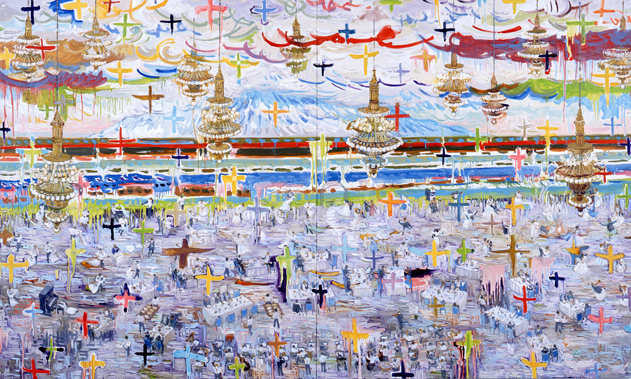You can stop worrying. The art of painting is in no danger. Its imminent demise is one of those things you hear muttered about from time to time from third-hand sources, but while painting may have lost some of its space in the art scene to installation work, multimedia and performance, the sky has not yet fallen.
I say this because Toru Kuwakubo is one of those painters that critics will hold up as an example of the vibrancy of contemporary painting. And they are right. The Telling of Sea, Telling of Painter exhibition at Tokyo Wonder Site, Shibuya, is the kind of show that reminds you what painting can accomplish. And as an early-career retrospective of Kuwakubo’s work, the show is a reasonably complete sampling, revealing an artist coming into his own.
There is a dose of the surreal in Kuwakubo’s work—in his older paintings we see people digging enormous holes in the beach, or waves awash with flowers. But his recent portraits of people adorned with fishing buoys, or of bottles with women serving as stoppers take it a step further. Portrait and still life blend at the edges as he decorates objects with people and people with unlikely objects—and sometimes people with people. And his heavy brushwork is settling into a confident style.
Kuwakubo’s signature works, however, are quickly becoming his massive landscape/seascape paintings. As the title of the exhibition suggests, the sea is a fundamental concept in much of Kuwakubo’s work, as is the sky. And his shorelines and beaches become stages where he builds his set pieces. In Wedding Banquet For Farmers, the beach is filled with tables and chairs, scattered dishes, chandeliers that inexplicably hang from the sky, and there is a festive glitter illuminating the clutter. In Carving Room, pillars and statues stand scattered throughout the landscape in a number of configurations. It is a room of carvings and a room for carving.
Clutter could be said to be a motif in Kuwakubo’s landscapes. It is as though he decides on a theme, a room, a thought, and then proceeds to fill the canvas with every possible object that he can associate with it. When he paints an atelier, it is all ateliers at once; it is filled with every likely thing that could be found in such a room. And although the canvas limits its size, the scene expands beyond the canvas borders, potentially going on forever—a shipwrecked idea that has washed up its contents on Kuwakubo’s shores.
Kuwakubo’s impressionist influences run deep. He has a strong, almost sculptural brushwork that causes the details to disappear into splodges of color as the viewer draws closer to the canvas. Details that may have seemed recognizable as a face become raised pillars of paint up close, and this mountainous texture subverts the details of the scene, becoming something else entirely. The pure abundance of apparent detail pulls viewers in, but the brushwork keeps pushing them back, and they are left looking at a scene that refuses to fully resolve—its details as loosely defined as an ocean shoreline.
If you think you need assurance that painting is alive and well, then this is at least one exhibition where you can take its pulse.
Show: Toru Kuwakubo: Telling of Sea, Telling
of Painter (to Sep 26) Gallery: Tokyo Wonder
Site, Shibuya (Shibuya station) Hours: 11am–7pm
(closed Mon) Admission: Free Tel: 03-3463-0603
www.tokyo-ws.org









